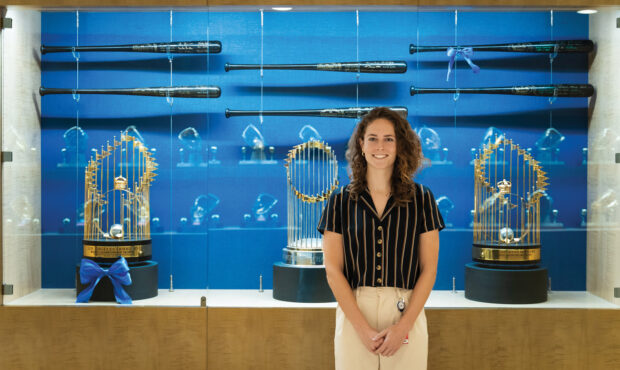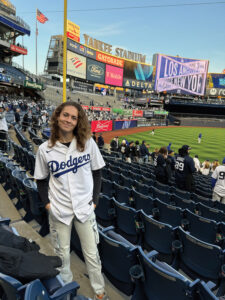Growing up as a Boston Red Sox fan, Melissa Hooke ’19 never imagined herself celebrating a championship at Yankee Stadium. Yet there she was, cheering as the “Commissioner’s Trophy” was raised into a beautiful October night sky in the Bronx. Hooke, a senior quantitative analyst with the Los Angeles Dodgers, had just become a World Series champion.
 Strangely enough, baseball wasn’t even her second favorite sport growing up. Hooke was recruited for basketball but also played soccer at Pomona. “I was looking at small liberal arts schools in New England, then visited Pomona and fell in love with campus,” she says. “Last minute, before early decision deadlines, I applied.”
Strangely enough, baseball wasn’t even her second favorite sport growing up. Hooke was recruited for basketball but also played soccer at Pomona. “I was looking at small liberal arts schools in New England, then visited Pomona and fell in love with campus,” she says. “Last minute, before early decision deadlines, I applied.”
She played midfield in soccer and guard in basketball, sometimes juggling both seasons. “Especially with our [soccer] team—we made the NCAA tournament a couple of times, so I’d join basketball midseason and have to catch up fast.”
Though an accomplished athlete, Hooke prioritized academics. “For me, it was always school first and then sports as an add-on.”
Like many incoming first years, Hooke wasn’t sure what she wanted to major in at Pomona, but after taking math and psychology courses, she ultimately declared as a math major.
“It was really my junior fall semester when I took a class with Jo Hardin [that] I decided that I really did love math and that there were career paths that attracted me,” she says.
Hooke’s time in the math department also brought her in contact with Associate Professor Gabe Chandler, a former Sagehens baseball coach who built an impressive pipeline to Major League Baseball—not for athletes, but for data analysts. Alongside his colleagues, Chandler has seen a remarkable number of graduates land roles in professional baseball analytics. Though he became Hooke’s thesis advisor, he never pushed her toward the sport.
“I don’t think I ever mentioned working in baseball, other than [sharing that] such career paths exist, as we’ve had a lot of alumni working in that space,” Chandler says.
Hooke and Chandler’s connection extended beyond academics. Athletics took a backseat for Hooke after knee injuries ended her college career, but she joined Chandler’s intramural basketball team, “which made a deep run in the playoffs, with Melissa hitting at least one game-winner,” Chandler recalls.
Academically, Hooke thrived under Chandler’s mentorship, earning Best Paper at the 2020 Institute of Electrical and Electronics Engineers Aerospace Conference for her thesis on Bayesian modeling.
A junior-year internship at the Jet Propulsion Laboratory (JPL) at the California Institute of Technology introduced Hooke to aerospace analytics, leading to a full-time offer before her graduation in 2019. While her foray into aerospace wasn’t necessarily expected, the position fit like a glove.
“I was working on early mission concepts and designs,” Hooke says. “Basically, they’d come up with some crazy idea and say, ‘we want to fly a probe into Jupiter’s atmosphere and figure out what the composition is. And we want to fly these four science instruments.’ I would help the team come up with that architecture and estimate the cost based on previously flown historical NASA missions.”
Hooke spent five years at JPL, enjoying the space industry before an opportunity with the Dodgers emerged: A former JPL colleague working for the Dodgers and aware of her sports background sent her a job listing and “wouldn’t let [her] get away with not applying.”
Hooke started with the Dodgers near the end of the 2023 season, just as the team finished with the third-best regular-season record, only to be eliminated in the first round of the playoffs. Heading into 2024, expectations were high.

Among Hooke’s duties as part of the 2023-24 analytics team: crunching the numbers to evaluate effectiveness of pitchers lower in the Dodgers’ depth chart.
“I think this year was a challenging year for the Dodgers, in some ways, with all the expectations. Obviously, the team dealt with a lot of injuries. And as an analytics department, we had experienced a few disappointing seasons leading up to this. So, going into the playoffs, there’s a lot of angst in the office. People are really nervous. A lot of people are too nervous to watch the games.”
Hooke’s Dodgers job is about removing emotions from decision-making in areas
such as player evaluation, game strategy and team management. She primarily works on pitcher evaluation.
“Math has pushed the game of baseball forward. As we get more data, we’re able to uncover more about why certain players are good,” she explains. “For pitching mechanics, we track pitcher movement, and teams can use that data to extract information about delivery mechanics—when a delivery leads to better outcomes, worse outcomes or even injury. That’s how we’re helping teams move forward.”
While analytics can clash with instinct and tradition, Hooke sees growing acceptance of its role.
“At the Dodgers, the coaches [and] executives really buy into it,” she says. “We have a culture of accepting it, and that trickles down to the players.”
That buy-in led to another successful regular season as the Dodgers finished with the best record in the MLB. But injuries left their pitching staff short-handed in the postseason. Part of Hooke’s job was to identify pitchers in the lower ranks who could contribute to a World Series-winning team.
The Dodgers made it to the World Series, and Hooke found herself on a team-chartered plane heading to New York. After falling behind 5-0 in Game 5, she recalled the team’s resolve.
“I think we kind of just said ‘well, we’ll get it done in L.A.’ And then, as the fifth inning progressed and we started coming back, we said ‘let’s just finish this off.’”
The Dodgers did finish it off, winning 7-6, and Hooke became a World Series champion.
“It was a bit of relief, but also just pent-up from the last few years,” she says. “Having a disappointing postseason ending before, everyone expected us to [disappoint again]. It was a celebration. It was different being in New York, but I’m glad that we were because it just tied together that magical experience.”


